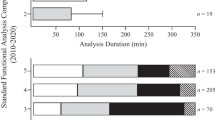Abstract
We replicated and extended the effects of an assessment and treatment model employed by Hanley et al. (Journal of Applied Behavior Analysis, 47, 16-36, 2014) with one participant receiving home-based services. Following a functional analysis, we taught the participant multiple functional communication responses (FCRs) and to tolerate delays and denials to requested items. The participant learned the FCRs and the delay to reinforcers was increased to 34 min. Results generalized across stimuli, people, settings, and time. Social validity results supported that the behaviors were important, the treatment was acceptable, and the effects were significant.


Similar content being viewed by others
References
Hanley, G. P., Jin, C. S., Vanselow, N. R., & Hanratty, L. A. (2014). Producing meaningful improvements in problem behavior of children with autism via synthesized analyses and treatments. Journal of Applied Behavior Analysis, 47, 16–36. https://doi.org/10.1002/jaba.106.
Iwata, B. A., Dorsey, M. F., Slifer, K. J., Bauman, K. E., & Richman, G. S. (1994). Toward a functional analysis of self-injury. J Appl Behav Anal, 27, 197–209. https://doi.org/10.1901/jaba.1994.27-197 (Reprinted from Analysis and Interventions in Developmental Disabilities, 2, 3–20, 1982).
Jessel, J., Ingvarsson, E. T., Metras, R., Kirk, H., & Whipple, R. (2018). Achieving socially significant reductions in problem behavior following the interview‐informed synthesized contingency analysis: A summary of 25 outpatient applications. Journal of Applied Behavior Analysis. https://doi.org/10.1002/jaba.436
Jessel, J., Hanley, G. P., & Ghaemmaghami, M. (2016). Interview-informed synthesized contingency analyses: Thirty replications and reanalysis. Journal of Applied Behavior Analysis, 49, 576–595. https://doi.org/10.1002/jaba.316.
Santiago, J. L., Hanley, G. P., Moore, K., & Jin, C. S. (2016). The generality of interview-informed functional analyses: Systematic replications in school and home. Journal of Autism and Developmental Disorders, 46, 797–811. https://doi.org/10.1007/s10803-015-2617-0.
Slaton, J. D., Hanley, G. P., & Raftery, K. J. (2017). Interview-informed functional analyses: A comparison of synthesized and isolated components. Journal of Applied Behavior Analysis, 50(2), 252–277. https://doi.org/10.1002/jaba.384.
Author information
Authors and Affiliations
Corresponding author
Ethics declarations
All procedures performed in studies involving human participants were in accordance with the ethical standards of the institutional and/or national research committee and with the 1964 Helsinki declaration and its later amendments or comparable ethical standards.
Ethical approval
This article does not contain any studies with animals performed by any of the authors.
Informed consent
Informed consent was obtained from all individual participants included in the study.
Conflict of Interest
The authors declare that they have no conflict of interest.
Additional information
• This study replicated and extended Hanley et al. (2014) by demonstrating the use of an open-ended interview to inform the design of a functional analysis, which quickly identified the function of one participant’s problem behavior in a home setting.
• Our open-ended interview suggested one function as opposed to a synthesized function, and the treatment effects demonstrated generality of the delay and denial tolerance protocol, further suggesting its utility for practitioners in applied settings.
• We demonstrated the efficacy of this procedure across settings by dedicating only 1 to 2 h per week to the described treatment and its durability across time, which offers implications for those selecting potential treatment options for FCT with limited service hours.
• We implemented FCT across a variety of responses, rather than the omnibus mand “My way” reported by Hanley et al. (2014), which may support the application of these procedures with learners with more advanced verbal repertoires.
Rights and permissions
About this article
Cite this article
Beaulieu, L., Van Nostrand, M.E., Williams, A.L. et al. Incorporating Interview-Informed Functional Analyses into Practice. Behav Analysis Practice 11, 385–389 (2018). https://doi.org/10.1007/s40617-018-0247-7
Published:
Issue Date:
DOI: https://doi.org/10.1007/s40617-018-0247-7




